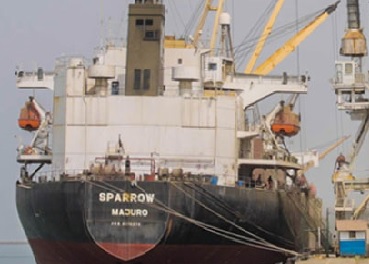Guinea possesses over 25 billion tonnes (metric tons) of bauxite – and perhaps up to one-half of the world's reserves. In addition, Guinea's mineral wealth includes more than 4-billion tons of high-grade iron ore, significant diamond and gold deposits, and undetermined quantities of uranium. Guinea has considerable potential for growth in agricultural and fishing sectors. Soil, water, and climatic conditions provide opportunities for large-scale irrigated farming and agro industry. Possibilities for investment and commercial activities exist in all these areas, but Guinea's poorly developed infrastructure and rampant corruption continue to present obstacles to large-scale investment projects.
Joint venture bauxite mining and alumina operations in northwest Guinea historically provide about 80% of Guinea's foreign exchange. Bauxite is refined into alumina, which is later smelted into aluminum. The Compagnie des Bauxites de Guinea (CBG), which exports about 14 million tonnes of high-grade bauxite annually, is the main player in the bauxite industry. CBG is a joint venture, 49% owned by the Guinean Government and 51% by an international consortium known as Halco Mining Inc., a joint venture of Dadco Mining and Rio Tinto Alcan. The Compagnie des Bauxites de Kindia (CBK), a joint venture between the Government of Guinea and RUSAL, produces some 2.5 million tonnes annually, nearly all of which is exported to Russia and Eastern Europe. Dian Dian, a Guinean/Ukrainian joint bauxite venture, has a projected production rate of 1,000,000 t (1,102,311 short tons; 984,207 long tons) per year, but is not expected to begin operations for several years. The Alumina Compagnie de Guinée (ACG), which took over the former Friguia Consortium, produced about 2.4 million tonnes in 2004 as raw material for its alumina refinery. The refinery exports about 750,000 tonnes of alumina. Both Global Alumina and Alcoa-Alcan have signed conventions with the Government of Guinea to build large alumina refineries with a combined capacity of about 4 million tonnes per year.
Diamonds and gold are also mined and exported on a large scale. AREDOR, a joint diamond-mining venture between the Guinean Government (50%) and an Australian, British, and Swiss consortium, began production in 1984 and mined diamonds that are 90% gem quality. Production stopped from 1993 until 1996, when First City Mining, of Canada, purchased the international portion of the consortium. The bulk of diamonds are mined artisanally. The largest gold mining operation in Guinea is a joint venture between the government and Ashanti Goldfields of Ghana. SociétéMinière de Dinguiraye (SMD) also has a large gold mining facility in Lero, near the Malian border.
Guinea has large reserves of the steel-making raw material, iron ore. Rio Tinto is the majority owner of the $6 billion Simandou iron ore project, which the firm says is the world's best unexploited resource. Rio Tinto has signed a binding agreement with Aluminum Corp. of China Ltd. to establish the joint venture for the Simandou iron ore project. This project is said to be of the same magnitude as the Pilbara in Western Australia.[citation needed] In the 1960s, Thomas Price, then vice president of US-based steel company Kaiser Steel, said, "I think this [the Pilbara] is one of the most massive ore bodies in the world.
In September 2011, Guinea adopted a new mining code. The law set up a commission to review deals struck during the chaotic days between the end of dictatorship in 2008 and Condé coming to power.






